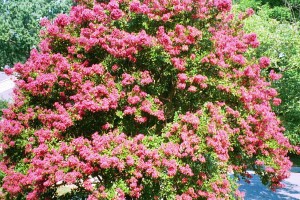 Growing up in the wilds of western New York State, crape myrtles were as foreign to me as winters without snow. I had a vague notion that they were nearly as important in the South, as camellias, but even northeastern greenhouses that were chock full of winter-flowering camellias were devoid of crape myrtle.
Growing up in the wilds of western New York State, crape myrtles were as foreign to me as winters without snow. I had a vague notion that they were nearly as important in the South, as camellias, but even northeastern greenhouses that were chock full of winter-flowering camellias were devoid of crape myrtle.
I was well into adulthood when crape myrtle seeped into my consciousness. I made a home in a less frosty Mid-Atlantic state that actually boasts the occasional winter with little snow. As I got acquainted with this part of the world, I started to notice crape myrtles, beautiful shrubs or small trees that bloom in high summer, right alongside the roses-of-Sharon. My daughter fell in love with them and would point out every single specimen that we encountered in our travels. She was desperate for me to plant one in our garden, even though we didn’t really have room. I finally gave in and made space for the purple-flowered crape myrtle that she fancied, only to have it die after a particularly chilly winter. This sad event was clearly a sign of both horticultural and maternal failure.
I have forgiven myself—at least mostly—but my failure at crape myrtle culture has also meant that now I see them at every turn, especially lately. Most are growing as small trees, topping out at about 25 feet. At this time of year, those trees sport lush flower panicles made up of scores of individual six-petaled blooms in shades including white, a range of pinks and roses, dark red and lavender.
Mid-summer beauty is delightful, but those of us without country estates or other large pieces of real estate need plants that can pull their weight in more than one season. Crape myrtle fills the bill. Most varieties have smooth grayish bark that exfoliates or peels off to reveal underbark that may be brown, gray or even pinkish. The effect is like elegant camouflage.
To add to the four-season equation, crape myrtle leaves, which are oblong and appear in groups of three, tend to be smooth and glossy, coloring up in the fall in shades of red, orange and yellow.
The most common crape myrtles in commerce are varieties or hybrids of Lagerstroemia indica, which is native to parts of Asia, including China, Indo-China and Japan. The genus is named for Magnus von Lagerstroem, an eighteenth century Swedish botanist who also happened to be a friend of the great plant taxonomist Linnaeus. When you have chums like Linnaeus, it is almost inevitable that plants will be named for you. This is what happened to Lagerstroem, allowing his name to live on in the form of an excellent plant.
“Crape myrtle” is often misspelled as “crepe myrtle”, an easy mistake that sometimes confounds the internet. The problem is complicated by the fact that the common name refers, according to more than one source, to the crepe paper-like quality of the flowers.
Spelling issues aside, the good news is that the universe of beautiful crape myrtle varieties has grown large and varied. Many were bred by Dr. Donald Egolf, a shrub specialist who worked at the National Arboretum in Washington in the nineteen fifties, sixties and seventies. His cultivars were often given Native American names, like ‘Osage’, a light pink variety that can grow to 20 feet; and ‘Zuni’, with lavender flowers and a maximum height of five to 12 feet. A good number of Dr. Egolf’s “children” are still in commerce.
Small space and container gardeners who crave crape myrtle can rejoice in the fact that diminutive varieties are commercially available in all the standard colors–if you know where to look. Pioneering work in this area was done by Dr. David Chopin, who is both a horticulturist and an attorney in Florida. Dr. Chopin’s miniature varieties start as small as the eight-inch tall ‘New Orleans’, which can be used as a ground cover. Other Chopin minis range from one to four feet tall. The smallest can be grown in large hanging baskets. Slightly larger specimens are perfectly suited to containers.
Whatever the size, crape myrtles like the same conditions as roses—full sun for at least six hours per day. If your chosen site receives a little less light, the tree or shrub may still thrive but will likely produce fewer flowers. Plant in well-drained soil enriched with organic material and mulch thoroughly.
Modern crape myrtles tend to be more cold tolerant than earlier varieties. Check the USDA zone hardiness recommendation on the plant tag. Chances are, if the plant is sold in a local nursery, it will thrive in your climate. When in doubt, plant the new crape myrtle in a relatively protected spot.
I have decided to try crape myrtle a second time, perhaps with one of the smaller varieties. If you are similarly inspired, look for specimens at your local nursery or garden center. For an extensive selection, especially of smaller varieties, go to The Crape Myrtle Company, an online-only vendor. Find them at www.crapemyrtle.com.
